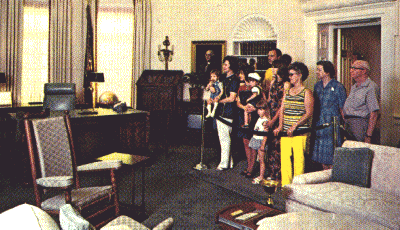
Visitors in the replica of the Presidential Oval Office,
in the Lyndon Baines Johnson Library, Austin, Texas.

Visitors in the replica of the Presidential
Oval Office,
in the Lyndon Baines Johnson Library, Austin, Texas.
With the conversion of print culture into video culture in the nineteen fifties and sixties, another change in the configuration of human knowledge and consciousness occurred. Instead of passively laying on the page where it took some small amount of effort for retrieval, information could now be blasted onto the back of the brain by high voltage cathode ray tubes. Everyday life is passively viewed as a spectacle. We like to watch. We watch submissively as our lives unfold on our TV sets.
The knowledge of self and identity is layered upon the knowledge of one's past and history: we are the cumulative product of our hopes and failures mixed with our ancestors' hopes and failures. However, history has become completely ironical for us. Our genealogies are narrative inventories squeezed through the reality filter of political agendas. One looks back at the past completely tethered to the perceptions and ideologies of the present. There is an infinite variety of alternate histories to our lives which are just as worthy and valuable as the next, and many of them coexist compartmentalized in our mental manifold. Our awareness of them depends upon what political quantum state we exist in at a particular moment in time.
However, the most prominent feature of humanity in this postmodern era is that everyone is totally clueless: they cannot differentiate reality from its hyperreal simulation. According to the inventory-compiling social historians, poll takers and bean counters, the majority of the population now believes that what they see on TV as being closer to the 'truth' than what they see in print. 'Seeing is believing' has replaced 'get it in writing.' The technological manipulation of information management has shifted completely from sound sense to visual sense.
The optical 'eye candy' environments of TV, slick magazines, shopping malls, etc. has created an insular, ironic virtual world complete with its own soap opera beliefs, laws, and morality. This has been achieved by the mechanical, brain-washing, repetitions (sex without passion), that over-exposes by media saturation and overloads the visual senses. One is seduced by advertisements to grab a style of life that is even 'better than reality.' We wear the right shoes and drink the right beer. Product identity has quickly become the most important organizing feature of modern life. It competes with nationalistic economic notions (that are no longer even understood by the 'experts'), just as political ideologies competed with religious views in a previous era. Brand name recognition in the form of particular type faces and fonts, trade mark emblems, and other modern hieroglyphic symbols which are linked by origin as being synonymous to certain corporations, are now instantly identified and understood in every demographic household. Even the everyday, common objects of our world such as clothing and food, have been replaced by corporate graffiti and simulacra: complete with manufactured desire that extends far beyond their useful function or basic need -- eroticised to seduce the weary consumer (or rather, replicant pod person ). The print culture belief that the world is a language to be read has been replaced by language as a body of information to be consumed.
The digital electronic revolution is closely on the heels of the video revolution. Hypertext culture has already quickly restructured vast landscapes of our society, even before the effects of video culture have completely replaced print culture. Change is getting ahead of itself. Presently, we are experiencing an era of cultural clashes, in which the way that we perceive information as a result of technology has far exceeded the capacity of the society to absorb it. The kinds of cultural changes which took centuries in previous times, are occurring at an increasingly geometric rate. Alterations in parts of our society have become totally unrecognizable and oblivious to others, while the connections between the cause and effect of the forces which reshape these segments of society have become increasingly unsynchronized. With the sudden and widespread use of hypertext as the result of the popularity of the World Wide Web, another refinement for the acquisition and perception of understanding is sweeping a large segment of our society.